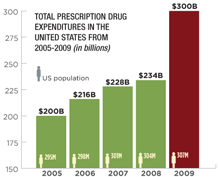Find out how drug formularies are helping to moderate drug costs.
Take a guess how many prescription drug orders were filled by Rhode Island pharmacists last year. One million? Five million? Ten million?
Try nearly 15 million, according to the Kaiser Family Foundation (KFF), a nonprofit organization that tracks healthcare costs.
In fact, prescription drug costs currently account for more than 19 percent of Blue Cross & Blue Shield of Rhode Island (BCBSRI) member claims. That makes prescription drugs one of the primary drivers of healthcare costs and, in turn, health insurance premiums locally. And the story is the same across the country. Nationally, prescription drug purchases reached $300 billion last year, a figure that is expected to continue to rise, according to industry experts.
Surprising? Probably not when you consider everyone needs a prescription drug at some point in their life. These medications play an important role in fighting disease and managing chronic conditions like diabetes, asthma, and high cholesterol. However, as more and more people turn to prescription drugs, the cost implications for consumers, health insurers, and the government are profound. Interestingly, one of the most effective approaches being used to tackle this complex issue is a relatively simple one.
Cost-saving solutionsPrescription drug formularies, the lists of drugs covered by health plans, help health insurers manage soaring drug costs while maintaining quality prescription drug benefits for their members, noted Charles Cote, a spokesman with the Pharmaceutical Care Management Association, the national organization that represents pharmacy benefit managers.
"Drug formularies are widely recognized as effective tools in lowering prescription drug costs while maintaining access and options for consumers," said Cote. "When drugmakers are forced to compete against one another for inclusion on an insurer's drug formulary, that competition drives prices down. Overall, consumers realize a savings of about 30 percent on prescription drug purchases."
Shopping smarterDrug formularies serve another important function: They help educate consumers about lower cost brand-name and generic drugs that are available. Because pharmaceutical companies spend so much money marketing their brand-name drugs, lower cost alternatives can easily be overlooked by consumers. Formularies not only result in better prices on prescription drugs, they raise awareness of the equally effective generics on the market, Cote pointed out.
It's important to note that lower cost does not mean lower quality. Generic drugs are, in fact, chemical equivalents to their more expensive counterparts and subject to the same U.S. Food and Drug Administration (FDA) safety and effectiveness requirements. And the savings can be substantial. According to BCBSRI claims data, the average cost of a brand-name prescription drug for a one-month supply is $153 (which is paid by both the member and the insurance plan), while the average price for a generic drug is $21 per month. This represents a monthly savings of $132 for a single prescription.
Cost-conscious consumers should ask their doctor or pharmacist about over-the-counter (OTC) medications as well. Many OTC drugs that once required a prescription—such as those used to treat allergies—are safe, cost-effective solutions for a host of health needs.
In an age when prescription drug spending makes up nearly a quarter of all healthcare spending, every effort—and every dollar—counts.






